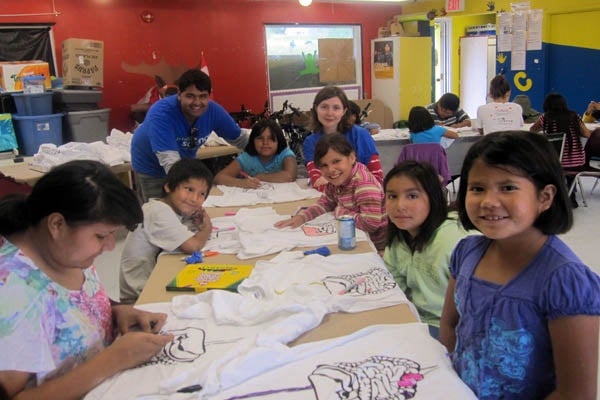
Let’s Talk Science, St. George, heads north for science camp
Published: October 18, 2011
What happens when a team of graduate students passionate about science and community outreach is invited to share their knowledge with a northern First Nations community? The result is a stellar science camp for First Nations children in Sandy Lake First Nation, Ontario.
Let’s Talk Science (LTS) is a national science outreach program that engages children and youth in science. A current goal of the program is to engage Aboriginal children and youth.
Inspired by this mandate, Julie Mason, one of the LTS St. George campus site co-ordinators, approached Anthony Hanley, an associate professor in the Department of Nutritional Sciences (DNS) and an investigator at the Sandy Lake Health and Diabetes Project (SLHDP) for some insight.
“The Sandy Lake Health and Diabetes Project continues to do amazing work in educating community members about diabetes prevention and treatment. It is pretty inspiring,” said Mason.
Hanley introduced Mason to Shannan Grant, a doctoral candidate in the department and a member of the diabetes project research team.
“Once I met Julie and saw her keenness and authenticity I knew we`d make a great team,” said Grant.
With the assistance of Hanley and Grant’s existing friendships in Sandy Lake, the pair got to work. Over the next year and a half, Grant and Mason raised more than $20,000 to cover expenses and recruited volunteers for their team. Together the group developed a camp curriculum with input from Let's Talk Science national and the Sandy Lake Health and Diabetes Project.
In August, Mason, Grant, and volunteers Bibiana Garcia Bailo, Andre Dias, (both nutritional sciences doctoral candidates) and Lilli Mauer, a nutritional sciences master’s candidate, spent a week in the Sandy Lake community, 450 kilometres northwest of Thunder Bay, helping with a science camp.
The camp ran from Aug. 15 to 19. Each day campers explored different topics through hands-on activities. On day one campers were given T-shirts with a full-sized picture of the digestive system. The Let’s Talk Science camp leaders explained how the digestive system functioned and then asked the students to identify the different parts as they coloured in their t-shirts. During days two and three, the campers learned about the remaining body systems as well as the science behind current nutrition recommendations.
Day four involved a nature walk in the bush guided by community members knowledgeable in traditional medicines and familiar with the forest area surrounding Sandy Lake. The DNS and community camp leaders married botany with traditional teachings and described the different parts of the plant and each plant’s species and family.
“Fifty campers joined us in the bush. The community was an amazing support; we learned as much from the community members as we taught the children” said Grant.
“The kids really related to this,” said Grant. “It was amazing how they just jumped on the topic.”
In addition to daily activities, the Let’s Talk Science leaders held an information technology (IT) night which focused on careers in IT and introduced the children to Let’s Talk Science’s online science program, CurioCity.
The week ended on day 5 with an outdoor science fair composed of games, raffles and performances by the campers. Dressed as different parts of the body, such as ears, teeth, tongues and bowels, the campers introduced themselves as a particular body part and recited how it functioned. As expected, the bowels drew some of the biggest laughs.
Mason and Grant stressed they couldn’t have held the camp without the support of the staff at the diabetes prevention and research programs in Sandy Lake. They are still analysing camper feedback, but feel that overall the camp was a hit. Their campers are certainly hoping there will be another session next year.
When asked if they will be involved in holding a camp next year, Mason and Grant said, “If we’re invited, we hope to help make it happen.”



